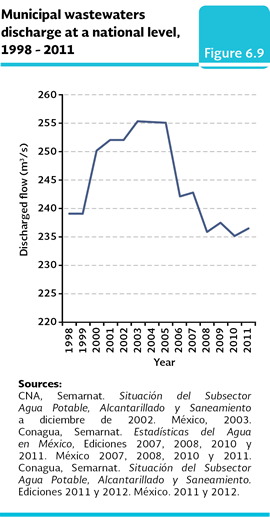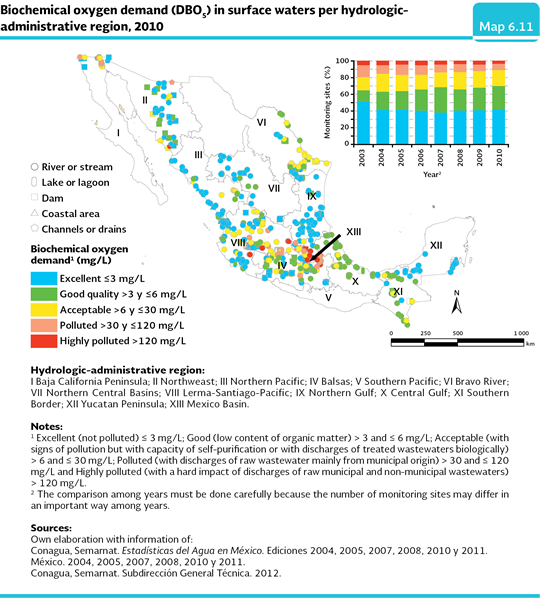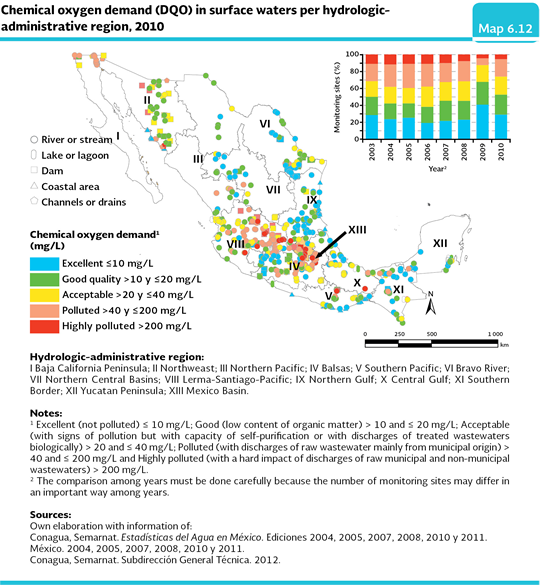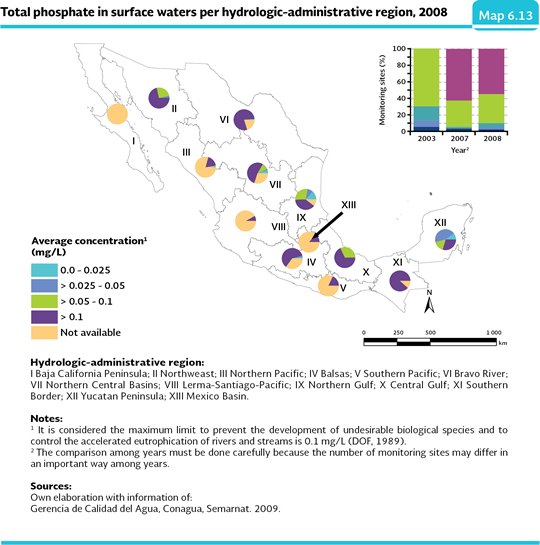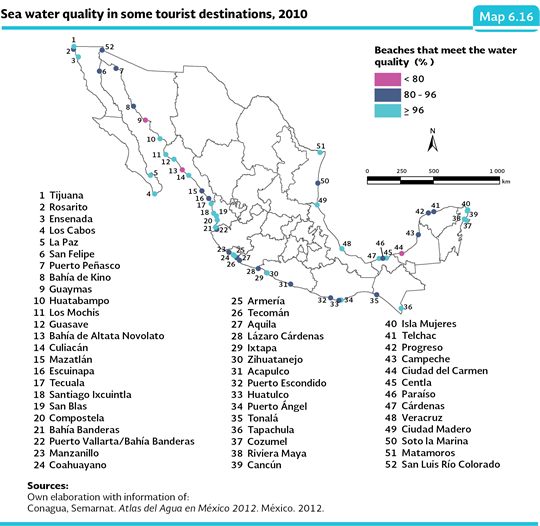
| CHAPTER 6. WATER |
WATER QUALITY The situation of water availability does not totally show the extent of the problem faced by the societies and the natural ecosystems. The continuous discharge of domestic and industrial wastewater without a treatment that eliminates the pollutants they have, as well as the runoffs with fertilizers and pesticides from the agricultural and livestock activities settled in several basins, cause the quality of the surface and groundwater is negatively affected, riskying the health of the population and the integrity of the ecosystems. The water quality is a feature defined by the use it is assigned to (for instance, as freshwater, for recreation, for agricultural or industrial use), which necessarily involves the existence of specific quality standards for the different uses (UNDP et al., 2000). The water quality of a surface or ground body depends on several factors, some of them reduce it either directly or indirectly, while others may revert the pollution changes and, therefore, improve it. Among the factors that reduce the water quality are the direct discharges of water or solid waste from the domestic, agricultural or industrial activities; the inadequate disposition in the soil of urban solid or hazardous waste may cause, indirectly, that surface runoffs and leachate pollute the water bodies and the aquifers. On the other hand, and acting to improve the water quality, it is the natural capacity of the marine ecosystems to decompose or immobilize the pollutants.
Wastewaters discharge The discharge of urban wastewater that come from the households, public buildings and from the urban runoff which are collected in the drainage. Their principal pollutants are nutrients (nitrogen and phosphorus), pathogens organisms (bacteria and viruses), organic matter, detergents, heavy metals, synthetic organic chemical substances, hormones and pharmaceutical products (Silk and Ciruna, 2004). In Mexico in 2011, the volume of wastewater coming from the urban centers was about 7.5 cubic kilometers (equivalent to 236.3 m3/s). This volume grew along with the population increase and the urbanization: between 2000 and 2005 the generation of wastewater from the urban centers increased about 7% (equivalent to 16 m3/s), although from that date until 2010, it was observed a decrease of the volume of the discharged flow rate going up again in 2011 (Figure 6.9; IB 2.2-1).
The country states that in 2011 generated most of the municipal wastewater were Mexico (26.17 m3/s), Distrito Federal (22.46 m3/s) and Veracruz (16.41 m3/s; Conagua, 2012), some of the most populated cities in the country, which, as a whole, accounted for 27.5% of the generated national volume (Map 6.10).
The discharges of non-municipal wastewater in 2009 were about 6.01 cubic kilometers (equivalent to 190.4 m3/s; IB 2.2-2), whose organic matter was equal to 6.95 million tonnes of DBO511 per year. These discharges into the water bodies grew 21 cubic meters per second between 2000 and 2009, it means, an increase of 12% of the discharged volume (Conagua, 2011).
Monitoring of water quality National Commission of Water (Conagua, in Spanish) makes the systematic measure of the quality of the liquid through its National Monitoring Network (RNM, in Spanish). In 2010, the RNM had 1,627 sites, 495 of them were in the primary network: 226 located in surface water bodies, 113 in coastal areas and 156 in aquifers. In the secondary networks there were 346 monitoring station, 282 of them were located in surface waters, 23 in coastal areas and 41 in groundwater. From the remaining sites, 701 belong to the special studies network and 85 to the reference network of groundwater: the sites with monitoring of the water quality are located in the principal water bodies of the country, including areas with high anthropogenic influence (Table D3_AGUA_RNM). The Conagua publishes among its principal indicators of water quality, the chemical demand of oxygen for five days (DBO5), the chemical demand of oxygen (DQO) and the concentration of total suspended solids (SST). Other parameters which are recorded in most of the RNM sites of the water quality are the nitrate concentrations (IB 2.2-10) and phosphates (IB 2.2-9), as well as their stiffness, dissolved oxygen and pH. The chemical demand of oxygen at five days is used as an indicator of the amount of organic matter in the water (IB 2.2-8 e IC 12). Its increase causes the decrease of the dissolved oxygen content in the water bodies, which creates “anoxia” conditions and produces negative effects in the biological communities of the aquatic ecosystems. In 2010, in 42.3% of the 652 examined monitoring sites, the DBO5 was below 3 milligrams per liter, which is considered as the maximum limit value for an excellent water quality (Figure 6.11). In contrast, nearly 11.3% of the monitored sites in the water bodies recorded the allowed maximum limit value to protect aquatic life in rivers. The largest amount of the sites with high DBO5 values (higher than 30mg/L and which are considered as polluted and heavily polluted) were concentrated in the center of the country: in the regions Mexico Basin, Lerma-Santiago-Pacific and Balsas (in 66.7, 18.1 and 14.7% of their sites, respectively), although some of them were also present in Baja California peninsula (22.7% of their sites; Map 6.11).
The chemical demand of oxygen (DQO) is frequently used as an indicator of the presence of substances coming from non-municipal discharges. The values over 40 milligrams per liter suggest the presence of discharges of waste raw water. In 2010, 26.5% of the 714 sites surpassed this limit; a little less than six per cent of them recorded average values over 200 milligrams per liter (Map 6.12). In the regions Baja California peninsula, Lerma-Santiago-Pacific and Mexico Basin between 46.7 and 77.3% of the monitoring sites had annual average concentrations over 40 milligrams per liter (Map 6.12).
Another frequent pollutant in the water bodies are the phosphates, which generally come from the compounds used as fertilizers in agricultural areas and from the detergents used in the urban areas, although they are also generated by the soil erosion and the decomposing organic matter discharged by industries, households and animal farming. Although the phosphates are not considered as toxic for human beings and animals, they may have indirect negative effects through the eutrophication of the surface water bodies, which involves the explosive growth of algae and the following dejection of dissolved oxygen (Carpenter et al., 1998). In 2008, in a little more than 35% of the 524 monitoring sites of the country the total phosphate concentration was over 0.1 milligrams per liter, which is considered as the maximum limit to prevent the development of undesirable biological species and to control the accelerated eutrophication of rivers and streams. The hydrological-administrative regions that surpassed this limit in more than 50% of the monitored sites were: Northweast (71%), Balsas (60%), Bravo River (78%), Northern Central Basins (53%), Central Gulf (68%) and Southern Border (88%; Map 6.13).
The nitrates are important components of the fertilizers which are originated by the ammonium oxidation (NH4+) and by other nitrogened sources present in the organic remains. They have adverse effects on the human health, causing cyanosis e, even asphyxia (Camargo and Alonso, 2007); while in the aquatic ecosystems they may favor the growth of algae and the decrease of the oxygen levels. In 2008, there was detection of concentrations 0.2 mg/L12 and up to 0.3 mg/L in 27% of the monitoring sites (out of 524 total sites) of the RNM (Map 6.14). In the regions Northern Gulf and Central Gulf, the 59 and 86%, respectively of the monitoring sites surpassed those levels.
Another indicator of the water quality is the amount of total suspended solids13 (SST) which come from the wastewater and soil erosion. The increase of SST levels in the water bodies affect the diversity of the aquatic life because they cause turbidity in the water and reduce the penetration of the solar light, preventing the development of the natural aquatic vegetation. The evaluation of the water quality in 2010, showed that out of the 799 monitoring stations that record total suspended solids, 20 were considered as polluted (2.5% of the total) and 5 (0.6%) as heavily polluted. The regions with the largest percentage of monitored sites with surface water pollution were Mexico Basin (14.8% of its sites) and Southern Pacific (5.6%). On the other hand, the regions with the largest percentage of their monitoring sites in surface waters with excellent quality were the Yucatan Peninsula (100%), Central Gulf (86.8%), Bravo River (73.1%) and Baja California peninsula (70.4%; Map 6.15).
The polluted water that runs through rivers and streams does not just have effects on the population that use it or the ecosystems where it is discharged, but also in the coastal areas where they discharge. The most common damages over the health that may be produced for swimming in polluted waters are the gastrointestinal diseases, the irritation on the skin and infections in the eyes and ears. Although, generally, these infections are not serious, the touristic activity may be affected when there beaches whose water lacks the required quality to preserve the health of the visitors. In order to monitor and improve the bacteriological quality of sea water in touristic beach destinations, in 2003 it was implemented the Integral Program of Clean Beaches and the National System of Information about the Water Quality in Mexican Beaches, where the Marine Secretariat (Semar) Environment and Natural Resources (Semarnat), Health (SS) and Tourism (Sectur). This program systematize and homogenize the sea water quality monitoring according to the criteria described by the World Health Organization (OMS) for recreation purposes. Currently, it has state health laboratories which follow the guidelines issued by the Health Secretariat and in coordination with this; they carry out the samplings and analysis of water in each one of the 17 coastal states in Mexico. Because of the technical and economic difficulty to determine all of the parameters related to the water quality, the fecal enterococcus are used as an indicator of the pollution degree of sea water and of the sanitary risks to use it with recreation objectives. According to the grading criteria of the water quality in the beaches from the Health Secretariat (based on OMS studies) the samples with a content of over 200 enterococci in 100 millimeters are not recommended for recreation purposes. In the beginning, in 2003, this program monitored a total of 226 sites in 35 touristic destinations of the coasts in the country, increasing to 338 beaches in 52 touristic destination to 2009 and in 2010, 245 beaches were monitored. From the beginning of the monitoring program most of the states have recorded an improvement in the water quality of their beaches. While in 2003, 93.7% of the samples met the water quality criteria by 2010 this value was 96.9%. Notwithstanding, the states with more sampled sites where the quality standards were not met in that period were Jalisco (with 9% of the total of samplings for the period), Chiapas (5%), Campeche, Veracruz and Sonora (with the 3% in each one of them). By 2010, the states with at least a beach that did not meet the water quality criteria were Sonora, Sinaloa, Guerrero and Campeche, (less than 2% of the monitored sites in all of the cases; Map 6.16).
Notes: 11 DBO5 corresponds to the biochemical demand of oxygen for five days. 12 It is established as a maximum concentration 0.2 mg/L for the long term consumption, in order to prevent the methaemoglobinemia in children (WHO, 2004). 13 It is considered the maximum limit 25mg/L (DOF, 1989).
|
